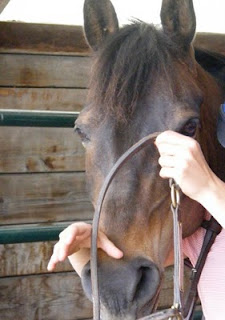I guess there were two things which convinced me to try teaching a trick or two. One was ponies who are so darn cute and the fun of showing their tricks to kids. I also approached a "trick" originally as a training tool. I taught Kizzy to target a cone for the purpose of using it in my lessons to direct her. The giggles from kids as a result was addicting.
The other was young horses in need of attention and entertainment. They were going to entertain themselves anyway by chewing on the barn, pulling up fence posts, using their teeth to explore the world (me, my clothes, and light switches that were supposedly horse-proof) and doing run-by spookings. I decided I might as well put all that energy and interest to good use. I decided if puppies get chew toys, why not young horses? I taught Percy last winter, as a weanling, to pick up his loopy toy and hand it to me. That gave him something to grab onto with his teeth and a way to interact with me.
This winter, I have expanded the list of "tricks" I am teaching and I'm seeing all the advantages to which I previously turned a deaf ear. First of all, winters in northern Vermont are long! I might as well use this time to train something rather than just hunkering down in the house with tea all day (while the horses find entertainment of their own). I've had that intention other winters but this year having some serious goals greatly increased the times I followed through with my good intentions. It will be interesting to see how things differ in the spring, when I simply transition to more riding/schooling from tricks as opposed to transitioning from nothing to training. I expect I'll have more attentive subjects than previously.
Secondly, because tricks are "useless", it takes the pressure off me. So what if Percy doesn't drop the toy in the basket? It's not going to affect his future as a performance horse! So I approach it lightheartedly and can truly enjoy spending the time with him and as a result he enjoys our time together also. That improves our relationship. He likes to see me coming and tries hard to do what I want. That is the kind of performance horse I want in the future!
Third, and this is the one that others really stressed, it really makes me a better trainer. It forces me to look outside the box. How do you get a horse on the bit? Well, I've been taught that in lessons, books, articles, clinics, etc. But to get a horse on the bit via positive reinforcement turns my mind into knots. I am so conditioned to the classical negative reinforcement of traditional training that it is difficult for me to come at standard expectations from a different direction. Or to throw the standard expectations out the window entirely. Because I am new to tricks, it's wide open and I can brainstorm different ways to approach training these things. This helps me to see all the different approaches that exist and hopefully will expand my options for teaching more traditional lessons. For example, I hope to have a video clip soon of my winter's work with ground driving Rumer. I have ground driven horses before and used that method for starting young horses, including Ande. But....with Rumer I am doing it without any harness or tack at all :) This isn't original of me. I sat with jaw hanging open as I watched Alex do it with horses on her videos and thought that would be an impossible feat for me to achieve. We're a long way from the smooth performance on the videos, but Rumer is so much more in tune with me already as a result that even if I never get any further, it will be well worth the time spent.
In addition to opening my mind to training possibilities, teaching tricks has really sharpened my observational skills as a trainer. I'm not exactly sure how things are going to go on any given day or what the results will be, so my eyes and mind are open to seeing what is really happening rather than what "should" be happening. When beginning to teach lateral work under saddle, we apply our aids and think the horse "should" respond by stepping over. If they don't, riders frequently just repeat the aids or increase their strength. Good trainers will observe what reaction the horse does have, and use that to refine their future training. I'll take all the practice I can get teaching a pony to stand on a silly mat to learn that lesson better. So many times, horses respond to cues we don't even know we are giving. An obvious example of that is the work I've done with Kizzy on the mat. I'll try to get that video posted soon. While I thought she had learned to stand on the mat, instead she had learned to stand in a certain way right next to me. When I moved, it didn't matter where the mat was, she lined herself up next to me. Then I had to untrain that! And I'm still working on it.
As humans, we have our way of communicating. But animals do it differently and we can be much more successful with them if we learn to engage them in the process and try to become more aware of what cues they are really picking up on as opposed to the ones we are delivering.
And now for a stupid dog trick- Beetle the dog waves goodbye.

And now for a stupid dog trick- Beetle the dog waves goodbye.





